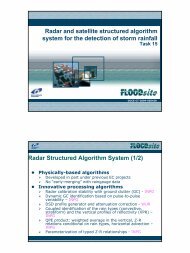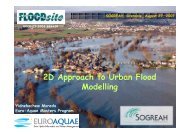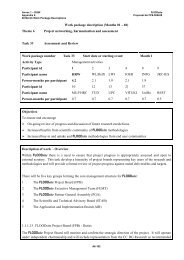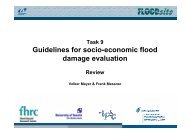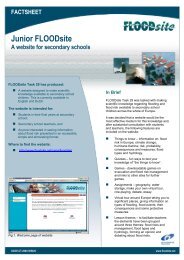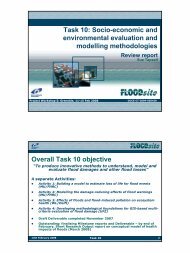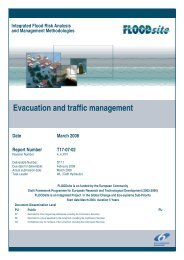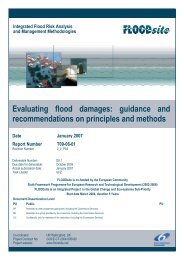Language of Risk - FLOODsite
Language of Risk - FLOODsite
Language of Risk - FLOODsite
Create successful ePaper yourself
Turn your PDF publications into a flip-book with our unique Google optimized e-Paper software.
<strong>FLOODsite</strong> <strong>Language</strong> <strong>of</strong> <strong>Risk</strong> 2 nd Ed.<br />
Contract No:GOCE-CT-2004-505420<br />
be aware <strong>of</strong> the fact that every language has its own “translation”, possibly with different notions <strong>of</strong><br />
these English terms.<br />
To identify these differences, the IRMA-SPONGE programme produced at the end <strong>of</strong> the project, a<br />
Glossary <strong>of</strong> terms with German, French and Dutch translations. The original IRMA-SPONGE<br />
glossary is reproduced in this report in Appendix 2, as an example only. It shows for instance that the<br />
Dutch language has three terms that can be translated by the common English term “Flood”.<br />
Such “many to one” correspondence <strong>of</strong> words in translation will mask the richness <strong>of</strong> meaning in an<br />
original language, thus both the French words “crue” and “inondation” may be translated in English as<br />
“flood” which misses out the different scale <strong>of</strong> the events implied in the native language. The English<br />
equivalent to “crue” (a small flood) might be “freshet” but this regional dialect word (from the<br />
England-Wales border area) is not in common national usage and so would fail to communicate to<br />
many in the UK. “Freshet”, however, is in use in North America but here is describes the flow from a<br />
spring thaw resulting from snow and ice melt in rivers located in the northern latitudes.<br />
As further illustration we might quote the word “dike” or “dyke”. The first definition in the Oxford<br />
English Dictionary for this word in common English usage is for a watercourse. The second definition<br />
is for a bank or embankment. However, within English translation <strong>of</strong> the use <strong>of</strong> the word from Dutch<br />
practice an embankment is meant, not a watercourse, and this usage is becoming standard in many<br />
internationally authored documents. In US practice the word “levee” is used (<strong>of</strong> course, not levée) for<br />
a dike or embankment. Another word related to an embankment is “cradge”, which in Eastern<br />
England means a minor embankment (providing protection from say, the annual flood), but in US<br />
usage a “cradge” is temporary raising <strong>of</strong> a defence for example by means <strong>of</strong> sand bags.<br />
Literal translation by non-experts may also be misleading, such as “lit mineur” being the “minor bed”<br />
<strong>of</strong> a river, which in English technical usage actually means “main channel”.<br />
In other cases a jargon word might be taken from one discipline into another and its common “natural”<br />
meaning obscures the intended concept; an example might be the word “fragility” in the context <strong>of</strong><br />
“fragility curves” for components <strong>of</strong> flood defences which express their probability to fail under a<br />
particular flood condition. A further problem with the word “fragility” in this context is that a flood risk<br />
manager does not naturally wish to communicate in public about the fragility <strong>of</strong> a flood embankment, but<br />
rather about its reliability, strength and safety.<br />
All these examples emphasise not only the need to define the terms (like “Flood”) unambiguously, but<br />
also the need to keep in mind that, some <strong>of</strong> those we communicate with will have another notion when<br />
hearing this word due to the “common” translation in the language they use at home.<br />
Given the broad use <strong>of</strong> technical terms within the risk assessment industry, establishing a common<br />
language <strong>of</strong> risk in the context in flood risk management is an essential aid to communication between<br />
European partners on the <strong>FLOODsite</strong> Project. However, without being aware <strong>of</strong> this “<strong>Risk</strong> <strong>of</strong><br />
<strong>Language</strong>” this report on the <strong>Language</strong> <strong>of</strong> <strong>Risk</strong> will not become our common Flood <strong>Risk</strong> Management<br />
Dictionary it is meant to be.<br />
1.3 The Layout <strong>of</strong> this Document<br />
This document first provides an overview <strong>of</strong> the concepts <strong>of</strong> risk and uncertainty to be used in the<br />
<strong>FLOODsite</strong> project, then includes standard definitions <strong>of</strong> various terms and finally, for those<br />
interested, a more technical discussion is provided in an appendix. In preparing this document we<br />
have identified some words which will need particular care in their use and interpretation, as there is<br />
scope for misunderstanding the concept between different pr<strong>of</strong>essional communities or national<br />
practices.<br />
T32_04_01_ <strong>FLOODsite</strong>_<strong>Language</strong>_<strong>of</strong>_<strong>Risk</strong>_D32_2_v5_2_P1 30 April 2009<br />
2



